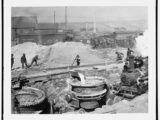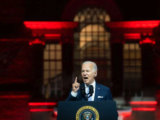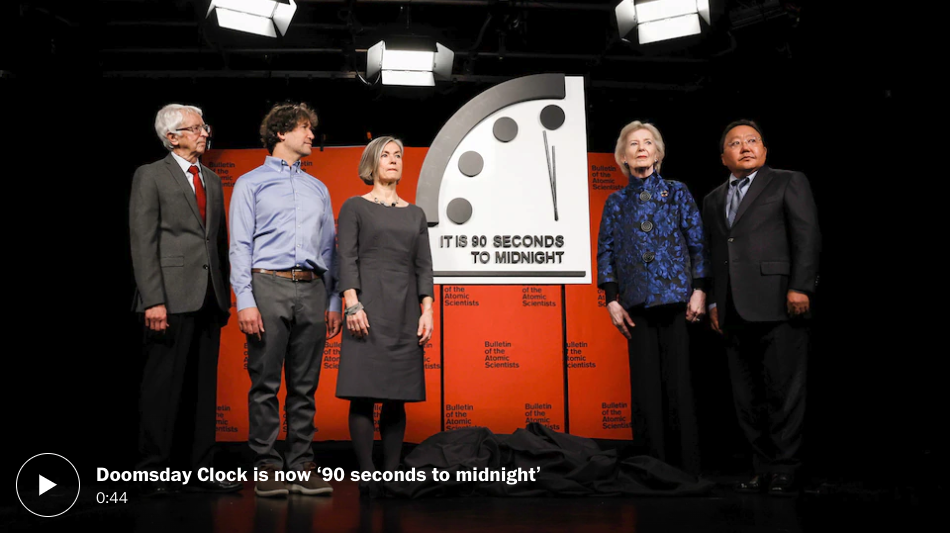
The Bulletin of Atomic Scientists updated the Doomsday Clock — which symbolizes the likelihood of worldwide catastrophe — on Jan. 24: NAJ screen shot
By Glynn Wilson -Â
WASHINGTON, D.C. — The Science and Security Board of the Bulletin of the Atomic Scientists set the hands of the Doomsday Clock at 90 seconds to midnight this week, the closest to global catastrophe it has ever been, largely because of the mounting dangers of Russia using nuclear weapons in the war in Ukraine.
“The war in Ukraine may enter a second horrifying year, with both sides convinced they can win,” the scientists say in the announcement at the University of Chicago.
“Ukraine’s sovereignty and broader European security arrangements that have largely held since the end of World War II are at stake. Also, Russia’s war on Ukraine has raised profound questions about how states interact, eroding norms of international conduct that underpin successful responses to a variety of global risks,” they say. “And worst of all, Russia’s thinly veiled threats to use nuclear weapons remind the world that escalation of the conflict — by accident, intention, or miscalculation — is a terrible risk. The possibility that the conflict could spin out of anyone’s control remains high.”
Russia’s recent actions contravene decades of commitments by Moscow, they point out. In 1994, Russia joined the United States and United Kingdom in Budapest, Hungary, to solemnly declare that it would “respect the independence and sovereignty and the existing borders of Ukraine” and “refrain from the threat or use of force against the territorial integrity or political independence of Ukraine…”
These assurances were made explicitly on the understanding that Ukraine would relinquish nuclear weapons on its soil and sign the Nuclear Non-Proliferation Treaty — both of which Ukraine did.
“Russia has also brought its war to the Chernobyl and Zaporizhzhia nuclear reactor sites, violating international protocols and risking widespread release of radioactive materials,” they say. “Efforts by the International Atomic Energy Agency to secure these plants so far have been rebuffed.”
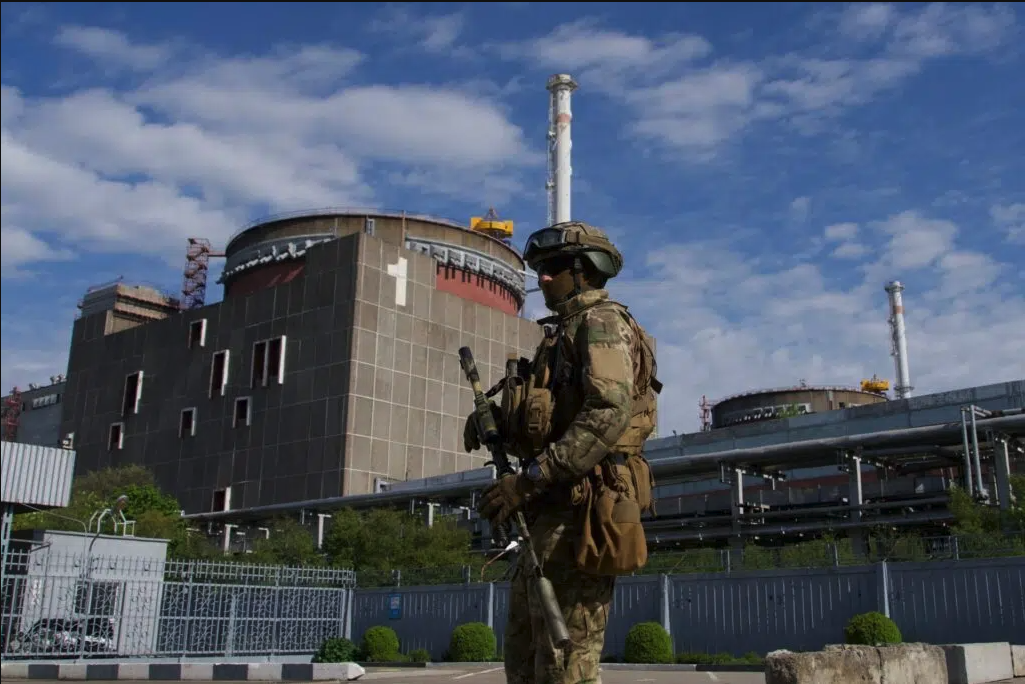
A Russian serviceman patrols the territory of the Zaporizhzhia Nuclear Power Plant on May 1, 2022: NAJ screen shot
As Russia’s war on Ukraine continues, the last remaining nuclear weapons treaty between Russia and the United States, New START, stands in jeopardy.
“Unless the two parties resume negotiations and find a basis for further reductions, the treaty will expire in February 2026,” they point out. “This would eliminate mutual inspections, deepen mistrust, spur a nuclear arms race, and heighten the possibility of a nuclear exchange.”
As UN Secretary-General Antonio Guterres warned in August, the world has entered “a time of nuclear danger not seen since the height of the Cold War.â€
The war’s effects are not limited to an increase in nuclear danger, however. They also undermine global efforts to combat climate change. Countries dependent on Russian oil and gas have sought to diversify their supplies and suppliers, leading to expanded investment in natural gas, exactly when such investment should have been shrinking.
“In the context of a hot war and against the backdrop of nuclear threats, Russia’s false accusations that Ukraine planned to use radiological dispersal devices, chemical weapons, and biological weapons take on new meaning as well,” the scientists say. “The continuing stream of disinformation about bioweapons laboratories in Ukraine raises concerns that Russia itself may be thinking of deploying such weapons, which many experts believe it continues to develop”.
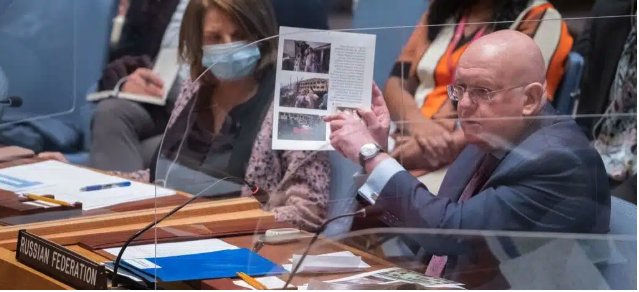
At a meeting of the Security Council on March 11, 2022, Vassily Nebenzia, Russia’s ambassador to the United Nations, accused the United States and Ukraine of concealing a bioweapons program. UN: NAJ screen shot
Russia’s invasion of Ukraine has increased the risk of nuclear weapons use, raised the specter of biological and chemical weapons use, hamstrung the world’s response to climate change, and hampered international efforts to deal with other global concerns. The invasion and annexation of Ukrainian territory have also violated international norms in ways that may embolden others to take actions that challenge previous understandings and threaten stability.
“There is no clear pathway for forging a just peace that discourages future aggression under the shadow of nuclear weapons. But at a minimum, the United States must keep the door open to principled engagement with Moscow that reduces the dangerous increase in nuclear risk the war has fostered,” the scientists conclude.
One element of risk reduction could involve sustained, high-level U.S. military-to-military contacts with Russia to reduce the likelihood of miscalculation, they say. The U.S. government, its NATO allies, and Ukraine have a multitude of channels for dialogue.
“They all should be explored. Finding a path to serious peace negotiations could go a long way toward reducing the risk of escalation,” they say. “In this time of unprecedented global danger, concerted action is required, and every second counts.”
The time had been set at 100 seconds away from midnight since 2020. The clock has been used for more than seven decades to convey the level of risk on Earth, from nuclear weapons to climate change. The clock is now at the closest point it has been to midnight — the symbolic hour of the apocalypse — since its inception in 1947.
At that time, the symbol was designed as an analogy for the threat of nuclear war, spurred by the Cold War arms race between the United States and the Soviet Union. The scientists originally behind the clock included some who had participated in the Manhattan Project, which produced the world’s first atomic bomb, including Albert Einstein.
The Bulletin’s science and security board decides the clock’s setting after researchers and academics assess trends such as the number of nuclear weapons in the world, the rate of sea-level rise and government efforts.
It’s “not a model spitting out a number. It’s a judgment among experts about whether humanity is safer or at greater risk†compared with the previous year and with previous settings in the clock’s history, said Rachel Bronson, the Bulletin’s chief executive, saying the organization hopes to bring the dire forecast “the attention it deserves.â€
Critics have dismissed it as “fearmongering,” or questioned its usefulness and the methodology. In a 2015 essay, a University of Oxford researcher in global catastrophic risk cast doubt on the clock as a measurement of “actual risk,†writing that it was more a reflection of the “strong feeling of urgency†about the risks among the team who operate it.
But the scientists who set the clock each year emphasized Tuesday that in moving it closer to midnight, they intended to signal that humanity is less safe and at greater risk, and that global leaders need to act urgently to address nuclear proliferation, climate change and global health.
“What we’re conveying with the clock move is, things are not going in the right direction, and they haven’t been going in the right direction,†Bronson said.
Mary Robinson, former president of Ireland and chair of the Elders, a group of former world leaders founded by Nelson Mandela, urged governments around the world to adopt Mandela’s “sense of urgency†and “spirit of humanity.â€
Elbegdorj Tsakhia, former president and prime minister of Mongolia and another member of the Elders, said world leaders are failing to do that.
“These existential threats laid out today should be cause for alarm,†Elbegdorj said. “Even more alarming is the continued failure of decision-makers to rise to the challenge despite urgent warnings they hear year after year.â€
The Bulletin has also cited the spread of cyberattacks and disinformation in recent decisions. The clock was furthest from “midnight†in 1991, when it was wound back to 17 minutes after the Cold War was officially declared over.
During the past year, the conflict in Ukraine has led to rising tensions between Washington and Moscow and shelling near Europe’s largest nuclear power plant.
“What we’ve been looking at is the unraveling of the international order … when two countries that control the largest nuclear arsenals in the world are at odds,†Bronson said. “And what we’re trying to say [is] that we really need to find a way to contain this crisis.â€
The countdown is more complex with the threat of climate change.
“As we’re talking about a slow and intense moving crisis,†Bronson added, “decisions we’re making now, we will feel in 30 years, and so how do we think about the clock?â€
She hopes the timepiece can provide not only a warning, but also some reassurance, by reminding people that “we have moved the clock back in the past, and that we are capable of this.â€
The scientists and academics behind the Doomsday Clock said there is reason to put faith in humanity’s ability to confront existential threats. The coronavirus pandemic demonstrated that health practitioners and policymakers are “emboldened†to work together in moments of crisis, said Suzet McKinney, principal and director of life sciences for real estate company Sterling Bay.
Renewable energy technology is also poised to become the world’s largest source of energy within perhaps the next five years, said Sivan Kartha, a senior scientist at the Stockholm Environment Institute and lead author for the Intergovernmental Panel on Climate Change’s Sixth Assessment Report.
Kartha added he is encouraged by the climate activism of the world’s youngest generations, who will face the consequences of failures to constrain fossil fuel use and slow global warming.
“We don’t anticipate ever being able to set it at midnight because at that point we won’t be able to do it,†Bronson concluded. “We won’t have any tools left to respond.â€
___
If you support truth in reporting with no paywall, and fearless writing with no popup ads or sponsored content, consider making a contribution today with GoFundMe or Patreon or PayPal.




